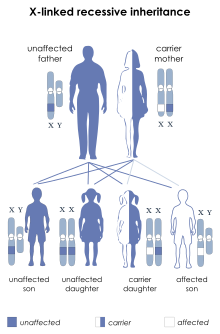User:Mr. Ibrahem/Becker muscular dystrophy
| Becker's muscular dystrophy | |
|---|---|
| Other names | Benign pseudohypertrophic muscular dystrophy[1] |
 | |
| X-linked recessive is the manner in which this condition is inherited | |
| Specialty | Pediatrics, medical genetics |
| Symptoms | Muscle weakness, muscle wasting[2] |
| Complications | Cardiomyopathy[2] |
| Usual onset | 5 to 15[3] |
| Causes | Genetic mutation[4] |
| Diagnostic method | Suspected based on symptoms, confirmed by lab tests, muscle biopsy, or genetic testing[3] |
| Differential diagnosis | Duchenne muscular dystrophy, polymyositis, spinal muscular atrophy, limb-girdle muscular dystrophy[4] |
| Treatment | Physical therapy[3] |
| Prognosis | Life expectancy 40s[3] |
| Frequency | 3 per 100,000 US males[4] |
Becker muscular dystrophy is genetic disorder characterized by slowly progressing muscle weakness and muscle wasting.[2] This generally begins in the legs and pelvis, resulting in trouble walking and falling.[3] The condition generally becomes noticeable between the ages of 5 and 15.[3] Complications may include cardiomyopathy, which is the most common reason for death.[2][4]
It is caused by a mutation in the gene which encodes the protein dystrophin.[4] It is inherited in an X-linked recessive manner.[4] It is a type of dystrophinopathy.[2] The diagnosis may be suspected based on symptoms and confirmed by lab tests, muscle biopsy, or genetic testing.[3] It is less severe than Duchenne muscular dystrophy, which also results from a mutation in the dystrophin gene.[4]
There is no cure, though physical therapy may improve symptoms.[3] Corticosteroids may be used in certain cases.[4] Becker muscular dystrophy affects about 3 per 100,000 males in the United States.[4] Rates in other countries vary from 0.1 to 7 per 100,000 males.[4] Life expectancy can be in to the 40s.[2]
References[edit]
- ^ "Becker muscular dystrophy: MedlinePlus Medical Encyclopedia". medlineplus.gov. Archived from the original on 15 March 2017. Retrieved 30 July 2019.
- ^ a b c d e f "Duchenne and Becker muscular dystrophy". NIH.gov. NIH. Archived from the original on 24 March 2017. Retrieved 17 April 2016.
- ^ a b c d e f g h "Becker muscular dystrophy | Genetic and Rare Diseases Information Center (GARD) – an NCATS Program". rarediseases.info.nih.gov. Archived from the original on 28 November 2020. Retrieved 20 January 2021.
- ^ a b c d e f g h i j Thada, PK; Bhandari, J; Umapathi, KK (January 2020). "Becker Muscular Dystrophy". PMID 32310552.
{{cite journal}}: Cite journal requires|journal=(help)
